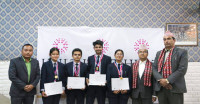Miscellaneous
Coming to the crease
These are heady days for Nepali cricket. Twenty two years after making their foray into world cricket through the 1996 ACC Trophy, Nepal has now become the youngest nation to be handed the One Day International (ODI) status.
Adarsha Dhakal
These are heady days for Nepali cricket. Twenty two years after making their foray into world cricket through the 1996 ACC Trophy, Nepal has now become the youngest nation to be handed the One Day International (ODI) status.
The journey, particularly the final hurdles in recent tournaments in Namibia and Zimbabwe, were not straightforward.
But the eighth place finish in the ICC Cricket World Cup Qualifiers means that the country now has the license to rub shoulders with the giants of world cricket, bringing the team one step closer to the ultimate dream of a Test Nation status.
Eight short years ago, Nepal was languishing in Division 5, the fifth rung of the World Cricket League ladder set up for Associate Nations under the International Cricket Council (ICC). But the early foundation laid by former coach Pubudu Dassanayake and captain Paras Khadka’s exemplary leadership has ensured that the country made a gradual, if oftentimes beleaguered, climb to the summit of world cricket.
This has opened doors for the national team to prepare itself for some eye-watering high profile fixtures, alongside receiving a host of additional perks that come with the coveted status. How the country now capitalises on the opportunities will determine not just how fruitful the next four years—the duration of the status—will be, but also the future trajectory of the sport in the country.

What does an ODI status mean?
With the ODI status, Nepal now joins an elite bracket of 16 teams that can play each other in 50-over ODIs. This means that the country can, at least in theory, host Test giants like Australia and India in its very own Tribhuvan University Cricket Ground.
The national team can now also play in either one-off ODI series or tournaments abroad. Along with the ODI status, a Twenty20 International status is also guaranteed, meaning Nepal will be direct entrants to the World Twenty20 Qualifiers, avoiding the tricky regional qualification process.
Moreover, if ICC’s pervious perks are continued, the biggest prize for Nepal could be entry into the four-day InterContinental Cup (ICup). The ICup is a First Class cricket tournament played between top Associate teams and serves as a gateway to becoming a Test playing nation.
The winner of the ICup, which will run from 2019-21, will compete against the bottom ranked Test side in a double legged playoff (two matches each at home and away) to have a shot at a Test status—the holy grail of the cricketing world. The 50-over World Cricket League Championship (WCLC)—also between top non-Test playing teams—will be another bonus for Nepal.
Additionally, the status also provides Nepal the space to formulate a robust development plan at home and generate funds from the ICC. This will be in addition to the yearly development fund of around Rs 80 million Nepal already receives.

Ground realities
Soon after Nepal secured the ODI status, social media naturally went haywire lauding the cricketers’ valiant effort, with fans already dreaming of clashes with Test giants. The ground reality for cricket, however, remains riddled with innumerable obstacles and challenges.
The ODI status comes as a result of the hard work and perseverance shown by the national team despite the Cricket Association of Nepal (CAN)—the nation’s governing body for the sport—remaining suspended by the ICC for the last two years. In the absence of a governing body, Nepal has had to compromise with pre-tournament preparations, with the full knowledge that the team would be competing in pitches in countries that have vastly different playing conditions than home.
In earnest, Nepal were lucky to come through the recent tournaments in Zimbabwe and Namibia where they won three out of four group games in last ball-thrillers before entering the final as league toppers with a negative net run rate. It, therefore, is nothing short of a miracle that Nepal’s new status among the elites of the game has been achieved without proper facilities, world-class stadiums, and lately even a domestic cricket setup.
Nepal’s only international standard ground—the Tribhuvan University Stadium—is badly worn out, and is often, in jest, compared to a paddy field. It has been a decade since the second international ground in Mulpani was conceived, but that project too is yet to truly take off. Adding, as insult to injury, Nepal’s only domestic tournament in the past year was the Prime Minister’s Cup—a short ODI affair.
One of the many memes that made rounds following the mass euphoria of earning the ODI status went as follows:
Do you have an international standard stadium?
No.
Do you have a cricket governing body?
No.
Do you have domestic cricket?
No.
What else does Nepal have then?
An ODI Status
Considering the far-from-ideal off-field conditions at home, it is a testament to the sport’s enduring popularity in Nepal, that it is still able to pull over 15,000 fans to the TU stadium for a domestic Twenty20 tournament organised by a private firm and that the national team boasts a 17-year-old prodigy leg spinner in Sandeep Lamichhane who will be soon competing in the most expensive Twenty20 tournament in the world—the IPL. It is no wonder then that fans are asking if Nepal even needs a perpetually-bickering cricket governing body?

Long road ahead
But, jest aside, Nepal cricket has now come to a stage where only a governing body with an efficient management can help the national team make the most of the hard-earned ODI status.
Former national team skipper and current U-19 coach Binod Das was over the moon with the result but remained cautious about predicting how exactly the next four years will pan out.
“It is really a great feeling to be an ODI nation. But, truth be told, we are in quite a precarious situation. This is the time when we need to establish relations with cricket boards from other countries. And to do that we need a decision maker that will represent a governing body. But we don’t have that at the moment,” said Das, referring to the absence of an administration.
“We have managed to reach this far because the ICC helped us in the build-up to the recent outings. But ICC will not be there to arrange bilateral series for us, prepare a domestic cricket structure or work towards building the much-needed infrastructure. We are on this long road by ourselves now,” the former captain added.
Nepali cricket is at a crucial juncture from where it can either be the next Afghanistan—whose management worked hard to get them their Test status—or become another Kenya who have failed to capitalise on their past glories and now languish in Division 3.
After delivering on the high expectations of millions of cricket fans, captain Paras Khadka is a relieved man but he knows the current euphoria is all but momentary. “The World Cricket League is very tough to compete in.
The ODI status means four years of safety for us,” said Khadka, an outspoken skipper who has on two previous occasions led player revolts against the working ways of the CAN in the past.
“The first issue that we need to address is setting up a proper management. Every one of us—players, coaches, cricket’s stake holders and sports officials—have to work collectively now to make sure we are able to draw the maximum benefits from this achievement,” he added.
But to reap benefits from the ODI status, the effort from just the cricket’s governing body, Khadka says, will not be enough, as it requires a huge amount of investment, along with a broad working mechanism to ensure Nepali cricket doesn’t lose its new found momentum. Those days might not be far when Nepal host Australia in a one-off one-dayer at the TU Stadium but is the country really ready to witness even one day of history in its own backyard?
Following the election of a new government, the country’s politics is gradually moving towards stability. The investment that will be required to propel cricket into new heights will no doubt be substantial; but if the cards are played right the new opportunities will bring with them the potential to generate eye-watering revenues that had previously been unheard of.
The day Nepal earned its ODI status, Ireland’s Kevin O’Brien, whose record fastest century sunk England during the 2011 World Cup in the subcontinent, congratulated Nepal by posting a picture of the Nepali crowd during the final of the Everest Premier League Twenty20 tournament, where more than 15,000 cricket lovers flocked to the TU Stadium.
“Looking forward to our first tour to experience crowds like this!” tweeted O’Brien, showing the Irish eagerness to play an ODI series in Nepal. O’Brien’s interest to play Nepal is just a reflection of what players from other cricketing nations, be it the Associates or full-fledged Test nations, desire. Nepal can now begin their international journey by hosting lowly-ranked ODI nations like Zimbabwe, Afghanistan, Ireland, the Netherlands or Scotland for bilateral or even a multi-team series.
World cricket governing body ICC has been pretty concerned that fixtures between lowly-ranked teams, especially after the commercial revolution brought by the advent of Twenty20, have not been able to create the excitement and yield good amount of revenue.
But with a strong fan base and ever-soaring popularity of the game, the platform has been laid for Nepal to become a front runner in becoming the most vibrant of cricketing nations. The ball, as they say, is now firmly in Nepal’s court.





 14.87°C Kathmandu
14.87°C Kathmandu










